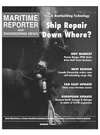
Page 56: of Maritime Reporter Magazine (August 1996)
Read this page in Pdf, Flash or Html5 edition of August 1996 Maritime Reporter Magazine
Eletson Tanker Takes Shape At NNS 58 Maritime Reporter,Engineering News
High-tech systems and time-saving products are beneficial to today ship-builders, but they are not substitutes for hard work and good attitudes. Newport News Shipbuilding (NNS) now has both working for it, to complete the first Double Eagle tanker for Eletson and to ensure its viability well into the next century.
The shipbuilder is now at the tail end of an overhaul of its production systems and process- es, a plan hatched in 1991 when NNS saw U.S.
Navy cutbacks as an opportunity to diversify its product and service offerings.
The results include a $120-million investment in robotics, computer-integrated manufactur- ing, and expanded drydock and refueling capa- bilities, with the new systems designed to pro- vide benefits on both the navy and commercial side.
The focus for improvement has been not only on new equipment and systems, but also on cre- ating and maintaining a highly motivated workforce which helps create and execute newly streamlined processes.
The very embodiment of harnessing "people power" is Mike Keenan, the energetic 30-year
Tenneco veteran who is the director of the yards' product tanker program.
Mr. Keenan, who started as a laborer/electri- cian at the yard in 1966, is in the office before dawn and leaves after dusk. He is truly 'under the microscope,' as the international maritime indus- try eagerly watches him guide
NNS' re-entry into the com- mercial shipbuilding market.
He knows the primary goal is to stick to Collis Potter
Huntington's mantra of "We shall build good ships here," but at the same time he is keenly aware of the competi- tive forces driving today's com- mercial shipbuilding industry.
Time is money, and while the first Double Eagle will take 15 months to build, the plan is to reduce that build time to "seven months, three weeks" by the seventh or eighth ship, said Mr. Keenan. "We now face a brutally com- petitive market," Mr. Keenan said. "There have been quan- tum leaps in processes and technology, and we are now facing very mature competi- tors." Aside from driving the cycle time down, he said another key for success is utilizing a global suppli- er base.
The imple- mentation of this strategy is readily seen in the first
Eletson ship,
Despotico, with its pro- pellers from Japan (Nakashima) and rudders from (Hamworthy).
Despot/co's MAN B&W diesel engine is lowered into place at Newport
News Shipbuilding. the U.K.
The stern section of the first double-hull tanker being built for Eletson.
Not long after this photo was taken, the section had to be lowered and secured in preparation for hurricane Bertha. Note: Pictured fifth from left (with a camera around his neck) is Gregory Hadjieleftheriadis, one of Eletson's director/owners, escorting a group to check the status of the newbuilding.
Still A Navy Yard, Always A
Navy Yard
While international attention has focused primarily on NNS' commercial business, it is clear that the shipyard is, and will always be, a military vessel construction facility. This was especially evident during a recent tour of the facilities, as three aircraft carriers were at the yard: Dwight D.
Eisenhower (CVN-69); John C.
Stennis (CVN-74); and Harry
S. Truman (CVN-75), which is currently under construction.
The yard is also a member of one of the teams bidding to build the 12-ship LPD-17 class of vessels. In a collaborative effort with Ingalls, Lockheed
Martin and NASSCO, the team has submitted a bid which D. Scott Stabler II,
NNS' LPD-17 program manag- er, hopes will end in a contract for the consor- tium when the contract is awarded in
September.
By many accounts, the LPD-17 program is radically different from any other Navy ship program, mainly due to the manner in which it was procured and will be evaluated. Major emphasis is being placed on life cycle costs; i.e. the projected cost to purchase, own and operate the ship. The level of team integration among traditionally competitive companies is also unprecedented. However, for the economic viability of the shipyards and the government, it may be the norm in the future. "Teaming will be an essential element in all future Navy pro- curement," Mr. Stabler said.
The same team that bid for the LPD-17 also recently won a $l-million contract from the
Defense Research Projects Agency (DRPA) and the U.S. Navy to provide initial design concepts for the arsenal ship program.
Along with the aircraft carriers and, poten- tially, LPD-17, NNS has several other strate- gies for military sales, including: FF21
Frigates for international sale; fast sealift ships; ship repair and overhaul; and aircraft carrier refuelings.
For more information on Newport News Shipbuilding
Circle 97 on Reader Service Card

 55
55

 57
57
